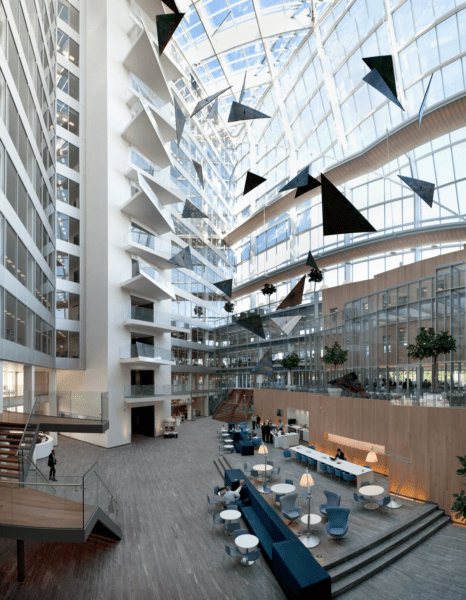Anyone who’s read a book or watched a movie recently should be able to appreciate how setting can be used to influence perception and expectations. Dark and stormy nights have been used to tell the audience that something scary is going to happen so often that the phrase has become a cliche, and sad protagonists seem to summon rain out of nowhere. These setting stereotypes aren’t just literary or genre conventions. The reason they’re used so often is because people react emotionally to the environment around them. We don’t need a movie to tell us that we should find darkness scary. Most of us just do, regardless of our cultural backgrounds.
It shouldn’t be any surprise then that the way our houses, schools and workplaces are designed can shape our mood. Research has found that uniform, plain building facades could increase boredom and stress in pedestrians. Long-term exposure to lots of boring facades could even lead to declining physical and mental health due to above-average levels of stress. Interior design can influence mood too. The presence of plants and plenty of natural light are associated with less stress, anxiety and depression. Since we spend so much time in or near buildings, isn’t it in our best interest to make sure that they shape our mood for the better?
This is particularly important as the effects of environment design can be very broad-ranging. For example, it has been found that ceiling height impacts how people process information. In a pioneering study, participants were placed in rooms which had either 8-foot or 10-foot high ceilings. Then they were placed in groups and asked to sort sports into whatever categories they wanted. The participants in the rooms with higher ceilings tended to use more abstract, creative categories such as the difficulty level of the sports. The participants in the rooms with lower ceilings focused on more concrete, specific details, such as the number of players on the sports teams.
Another study has found that looking at nature can increase attention and focus. College students who could only see urban, man-made structures from their windows scored lower on mental focus tests than those who could see more natural environments. Both these studies suggest that environment design could even impact productivity. If you want someone to focus, then give them some natural landscapes to look at. Schools like the Paul Chevalier school in Lyons, France have used outside spaces, wide windows, skylights and strategically situated green roofs to give students plenty of natural light and ensure a good view of nature wherever they are. Factors such as ceiling height can also make people better or worse at particular tasks. If you’re looking for creativity and abstract thinking, a higher ceiling could help. Alternatively, if you want people to focus on the details, lower the ceiling height. These insights aren’t useful only to people who want to influence their own performance. Schools and companies should also be interested in these insights, as they can help people work more efficiently and effectively.
Of course, it could be argued that these effects are purely due to cultural conditioning. By this logic, it wouldn’t really matter in the long run what the built environment looks like. We could make every house an identical grey, windowless box and eventually people will come to prefer them due to evolving societal expectations. There is evidence that aesthetics are culturally influenced. For example, one study found that different cultures prefer different interior design palettes, perhaps due to different cultural meanings surrounding particular colours. Additionally, there is evidence that aesthetic preferences around the built environment are already being changed by more utilitarian modern design styles, as urban populations around the world are getting increasingly comfortable with minimalist styles.
It’s reasonable to assume that culture plays a large role in shaping aesthetic preferences. However, it’s worth noting that the natural environment also plays a large role in shaping culture. A good example of this is how lighting is used and perceived across different latitudes. No matter where they are, people tend to form their ideas of how it should work based on their experience with natural light. However, the effects of natural lighting vary a lot depending on where you are in the world, leading to cultural differences. For example, colourful street lighting is rare in southern Europe, possibly due to its unnatural connotations. Nordic people, on the other hand, are more tolerant of colourful lighting, possibly due to their exposure to the aurora borealis. The desirability of long shadows over building facades is also influenced by latitude, daylight duration, and the angles people are used to perceiving natural light at. The result is cultural differences in aesthetics. However, these differences are not at all arbitrary and would be very difficult to change as they reflect the constant features of the environment people live in.

What can we do to make sure that our buildings are good for our mood? Firstly, more research is needed to determine what aesthetic preferences different cultural groups have. So far, research on the psychological effects of buildings has mostly focused on North American and European participants. As we’ve seen, there are some culturally ingrained, difficult-to-change differences in the ways the built environment affects people. Trying to generalise the findings from studies on Western populations could therefore lead to designs which other cultural groups don’t like. Additionally, advances in technology should be applied in order to help researchers generate more valuable insights. An example of this is how advances in functional brain imaging let us better see how people respond to a stimulus. This has supported the growth of neuro-architecture. Finally, it’s crucial that research findings actually get transmitted to the architects who design our cities. Increasingly, some buildings, such as the Edge Deloitte office buildings in Amsterdam (pictured), are being designed to influence mood for the better. However, there is still a lack of awareness that this is necessary. Events like the Conference on Conscious Cities intend to accomplish this by creating connections between architects and academics.
Traditionally, not much attention was paid to how our cities can affect us psychologically and cognitively. In fact, the utilitarian architectural styles that have emerged over the past decades emphasised functionality at the cost of aesthetics. A growing body of research suggests that this approach is flawed. Buildings can not only affect mood, but also a whole range of important factors. They can influence patient outcomes, affect whether we think in an abstract or detail-oriented manner, and improve or worsen our attention. Going forward, we should take action to make sure our built environment reflects this. This includes but is not limited to fostering ties between academics and architects. However, it’s important to bear in mind that there are cultural differences in architectural and interior design preferences. It’s important to make sure that our attempts to improve our cities are culturally sensitive and inclusive.
Featured image: Pexels






